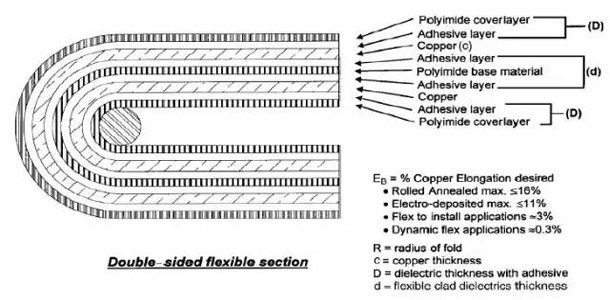How to calculate the bending radius of FPC ?

When FPC flexible circuit board is bent, the stress types on both sides of the core line are different.
The inside of the curved surface is pressure, and the outside is tensile. The magnitude of stress is related to the thickness and bending radius of FPC flexible circuit board.
Excessive stress will make FPC flexible circuit board lamination, copper foil fracture and so on. Therefore, the lamination structure of FPC flexible circuit board should be reasonably arranged in the design, so that the two ends of the center line of the curved surface should be symmetrical as far as possible.
At the same time, the minimum bending radius should be calculated according to different application situations.
Situation 1. The minimum bending of a single-sided flexible circuit board is shown in the following figure:
Its minimum bending radius can be calculated by the following formula: R= (c/2) [(100-Eb) /Eb]-D
The minimum bending radius of R=, the thickness of c= copper skin (unit m), the thickness of the D= covering film (m), the permissible deformation of the EB= copper skin (measured by percentage).
The deformation of copper skin varies with different types of copper.
The maximum deformation of A and pressed copper is less than 16%.
The maximum deformation of B and electrolytic copper is less than 11%.
Moreover, the copper content of the same material is also different in different usage occasions. For a one-off bending occasion, the limit value of the critical state of fracture is used (the value is 16%).
For the bending installation design, use the minimum deformation value specified by IPC-MF-150 (for the rolled copper, the value is 10%).
For dynamic flexible applications, the deformation of copper skin is 0.3%. For the application of magnetic head, the deformation of copper skin is 0.1%. By setting the allowable deformation of the copper skin, the minimum radius of curvature can be calculated.
Dynamic flexibility: the scene of this copper skin application is realized by deformation.
For example, the phosphor bullet in the IC card is the part of the IC card inserted into the chip after the insertion of the IC card. In the process of insertion, the shell is deformed continuously. This application scene is flexible and dynamic.
Situation 2, double-sided board
Among them: R= minimum bending radius, unit m, c= copper skin thickness, unit m, D= coverage film thickness, unit m m, EB= copper skin deformation, measured by percentage.
The value of EB is the same as that above.
D= interlayer medium thickness, unit M.

The information below is required for social login
Sign In
Create New Account